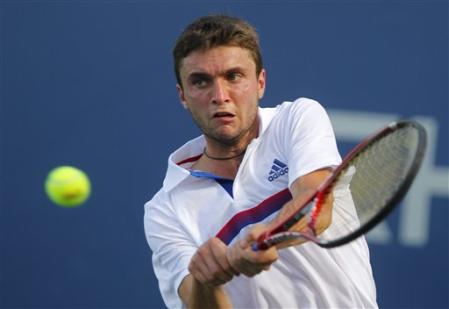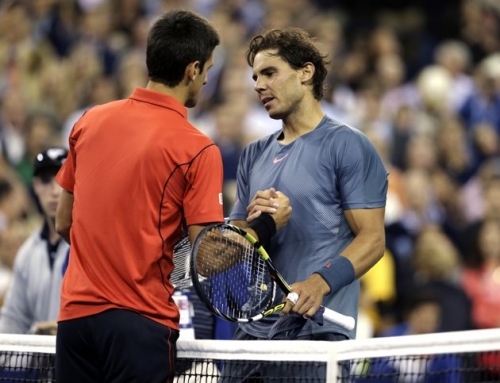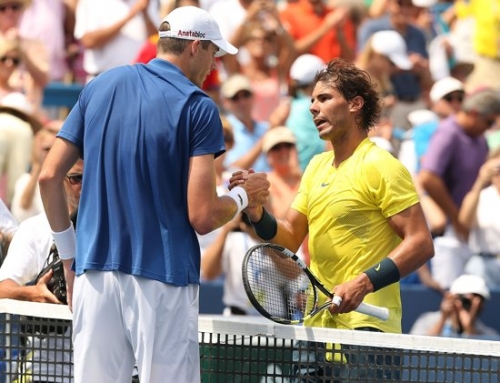 Gilles Simon is a peculiar player for a high-level tennis player. Male tennis players have a certain machismo when they play tennis. Perhaps no one embodies this more than players like Fernando Verdasco or Fernando Gonzalez. These two would rather hit you off the court with big shots than to win playing finesse.
Gilles Simon is a peculiar player for a high-level tennis player. Male tennis players have a certain machismo when they play tennis. Perhaps no one embodies this more than players like Fernando Verdasco or Fernando Gonzalez. These two would rather hit you off the court with big shots than to win playing finesse.
Some players, like Tomas Berdych, Robin Sodering, or John Isner, have to use their big hitting to hide flaws in their games, namely, their mobility. They aren’t just hitting hard just because they can, but because they don’t run well enough to play any other style.
Gilles Simon, by contrast, has great stamina and very good speed. For his style, he does hit flatter than he should, but Simon dares you to hit a hard shot. He plats a lot of low-pace shots up the middle. Can he hit hard? Yes, he can. But he rarely resorts to it unless he’s in trouble. He hits shots up the middle over and over again, baiting you to hit that big shot.
Were Simon in better shape, he might have beaten Mardy Fish, but Fish hit just enough hard shots of his own and Simon missed just enough shots that Fish was the victor.
To make a movie analogy, the last two Batman movies put two kinds of bad guys for Batman to face. In “The Dark Knight”, the bad guy was the Joker. He wasn’t a fighter or physically imposing. Instead, he forced Batman to make choices he didn’t want to make. He got into Batman’s head. By contrast, “The Dark Knight Rises” featured a physically imposing “Bain” who resembles James Bond bad guys, seemingly all-powerful and seemingly impervious to pain.
In that respect, players like Soderling or del Potro play a “Bain”-like style while players like Simon play like “The Joker”.
Novak Djokovic came into the finals playing very good tennis. del Potro tried to hit his way through Djokovic, but Djokovic was a human backboard, getting shot after shot back. David Ferrer, despite his lack of firepower, pretty much tried the same style.
That presented Murray a dilemma. Murray lacks the topspin and firepower to consistently hit through Djokovic. This has caused him problems against Nadal. Murray ends up making more errors than winners. And, with the wind in the finals, this strategy has its own problems.
So Murray went after a different tactic. He played lots of shots up the middle. He also tried moving the ball left and right, but without producing the angles that today’s players can produce. Indeed, Murray seemed to want to potentially win the long way. He rarely went after huge winners if he could extend the point.
This left Djokovic flummoxed. He seemed to have no idea what to do. Murray was also trying to let the wind affect the ball, so Djokovic often looked off-balanced.
Djokovic almost got away with his poor play when the wind calmed down, and he was able to go after his shots. But, by the fifth set, Murray had made Djokovic run so much that he was starting to cramp. Even had Murray failed to serve out the set, he should have still won, provided Djokovic was actually hurt.
This is one area where Murray tends to excel. He can play you one of many different ways. At Wimbledon, he played a lot of finesse shots, bringing back the style he used to play. At the Olympics, he played his power game, perhaps due to the best of 3 set up. And, in the finals of the US Open, Murray tried to move Djokovic around, make him work, yet be uncertain of his shots. He tried to remove the angles so Djokovic couldn’t fire his own angles, but to play that, Murray had to play long points, goading Djokovic to go for shots.
Maybe Gilles Simon had nothing to do with why Murray played the way he did, but certainly, he came up with an unusual way to play Djokovic, given the obvious tactic of hitting through Djokovic was not likely to work.




![[US Open Men’s Final] Can Djokovic beat Nadal in the finals?](https://www.essentialtennis.com/wp-content/uploads/2013/09/20130909djokovic-500x383.jpg)


![[French Open] The tactics of the Djokovic-Nadal semifinals](https://www.essentialtennis.com/wp-content/uploads/2013/06/20130607nole-500x383.jpg)